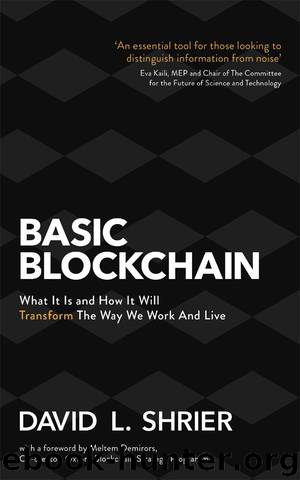Basic Blockchain by David L. Shrier

Author:David L. Shrier
Language: eng
Format: epub
Publisher: Little, Brown Book Group
Grid management
Management of the energy grid can be empowered by blockchain. Historically, energy distribution was a one-way street. Utility companies would produce energy and send it to consumers’ homes. As consumers install solar generation tech at home, and ‘smart grid’ technologies are implemented to manage load, we are witnessing the emergence of a bilateral energy economy. Consumers aren’t just paying for energy to be transmitted to their homes; they are also sending back surplus energy generated during peak solar production. By keeping energy transmission to a localised level, efficiencies can be introduced by reduction of transmission loss.
Blockchain offers the possibility of seamless, dynamic, multilateral energy markets.29 In geographies ranging from Australia to Estonia to Brooklyn, NY, we are seeing efforts to implement microgrid-blockchain from companies such as WePower and Brooklyn Microgrid (part of the Consensys family).30 Peer-to-peer (p2p) energy markets represent a potential democratisation of end-point energy management, facilitating more efficient markets and lower costs to consumers.
Provenance emerges as a factor also. Consumers are selecting green energy, for example, in lieu of gas or oil. This requires knowledge and certification of how the electricity is produced and a mechanism to ensure that it isn’t commingled with ‘dirty’ energy sources such as coal.
The application of blockchain to energy distribution management isn’t limited to the retail market. Wholesale energy management is a complex endeavour capturing multiple actors (including government as well as the private sector) and requiring the transmission not only of energy itself but also volumes of data across an interconnected set of disparate entities. Hydropower might be produced in Quebec, and then transmitted to a high-energy-consumption locale like Massachusetts.31 The wholesale energy market, likewise, would benefit from the transparency, ease of data sharing and automated balancing of multiple actors that blockchain provides.
There are other areas in which blockchain can potentially add value. Utility companies can do a better job of inventory management, at a lower cost, through the implementation of automated blockchain asset management systems. Billing and smart metering could see greater automation with blockchain. Transitioning from one energy supplier to another could be facilitated with the data portability that blockchain could enable.
If we think about the strategic goals of government, we see opportunities to apply convergent technologies (instances in which we combine two or more recent innovations, including blockchain). Municipal and regional economic analysis could be conducted for the purposes of (1) understanding economic development; (2) assessing progress towards UN Sustainable Development Goals; and (3) infrastructure planning. Econometric insights, for example, could be made more transparent, leading to more efficient ways of addressing energy consumption and demand variability. These functions are greatly enhanced by combining artificial intelligence, big data systems and blockchain.
Download
This site does not store any files on its server. We only index and link to content provided by other sites. Please contact the content providers to delete copyright contents if any and email us, we'll remove relevant links or contents immediately.
The Black Swan by Nassim Nicholas Taleb(6762)
Bad Blood by John Carreyrou(6274)
Pioneering Portfolio Management by David F. Swensen(6078)
Millionaire: The Philanderer, Gambler, and Duelist Who Invented Modern Finance by Janet Gleeson(4093)
Skin in the Game by Nassim Nicholas Taleb(3965)
The Money Culture by Michael Lewis(3846)
Bullshit Jobs by David Graeber(3828)
Skin in the Game: Hidden Asymmetries in Daily Life by Nassim Nicholas Taleb(3720)
The Wisdom of Finance by Mihir Desai(3523)
Blockchain Basics by Daniel Drescher(3329)
Liar's Poker by Michael Lewis(3220)
The Intelligent Investor by Benjamin Graham Jason Zweig(2930)
Hands-On Machine Learning for Algorithmic Trading by Stefan Jansen(2925)
Mastering Bitcoin: Programming the Open Blockchain by Andreas M. Antonopoulos(2891)
Fooled by Randomness: The Hidden Role of Chance in Life and in the Markets by Nassim Nicholas Taleb(2860)
Investing For Dummies by Eric Tyson(2791)
The Power of Broke by Daymond John(2770)
Market Wizards by Jack D. Schwager(2538)
Zero Hour by Harry S. Dent Jr. & Andrew Pancholi(2531)
